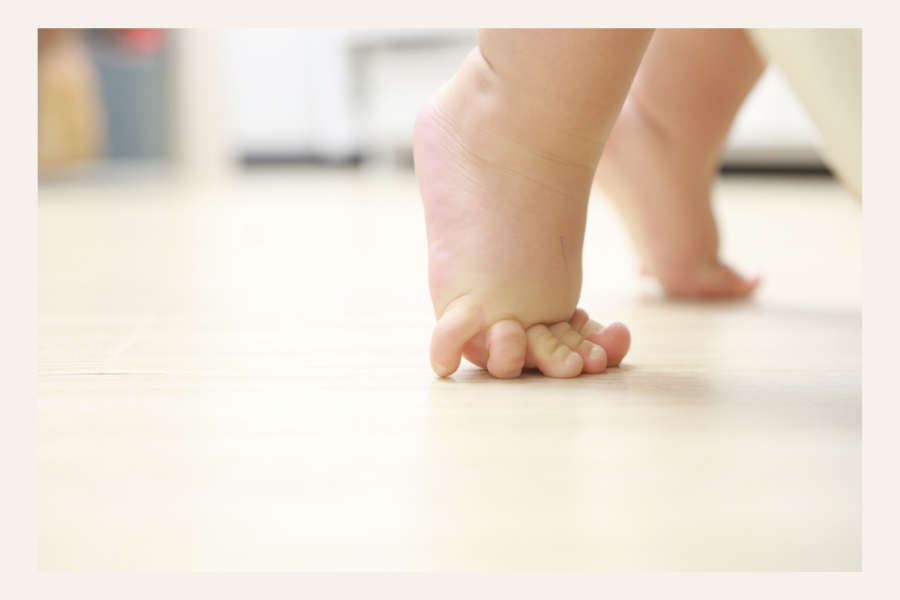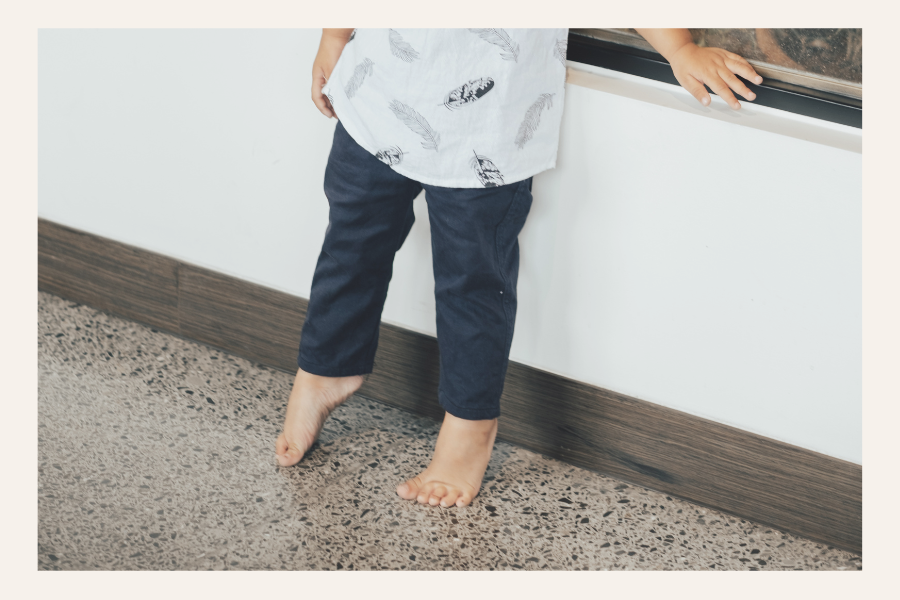Toe Walking in Children | What to Know, Tips to try, and When to Ask for Help.
Toe walking can get an intimidating, “always bad” reputation, but that just isn’t always the case, so let’s talk about it! The reality is, being able to rise onto toes is an absolutely functional movement that assists us daily in things as simple as reaching into a higher cabinet, all the way to more complex skills like jumping with both feet.
In turn, seeing exploration of intermittent tip toe walking can absolutely be a normal part of development. But when IS it something worth looking into?
If you begin to see toe walking emerge as a consistent pattern, meaning your child is doing it more than 60-70% of the time, or is unwilling or unable to get heels down with simple cues, it may be time to take some action. Speaking with your pediatrician and determining if an individualized PT assessment is needed can be a great first step. When it comes to activities that may help – focusing on dorsiflexion, which is the ankle motion where the top of the foot comes closer to the shin, can be key. Basically, dorsiflexion is the opposite of the motion that occurs during toe walking, which when persistent, can result in tightness of the calf muscles.
With that quick overview done, let’s talk through more about what is happening during toe walking, when a PT eval may be warranted, and some activities you can try at home.
Why Might My Child Be On Tiptoes?
There can be several factors that play into why your child is toe walking. Two of which are related to age & current milestones underway.
For example, tip toe positioning seen in newly cruising babies, meaning side-stepping along furniture with hand support, is most often that the support surface is slightly too high.
Remedying tip toes in this case can sometimes be as simple as lowering the support that they’re using. Taking off the couch cushions, holding their hands at waist level, or even placing your hands on their waist and giving gentle pressure downwards to encourage heels flat on the floor, are all options to help.
You may also see it when a child is using something like a push walker to take assisted steps through their environment. In this case, it is often that it is moving too quickly for them, and they haven’t quite mastered the balance between the front and back muscles on their body to stabilize and slow them. In this case, moving to a surface like carpet over hardwood, or even using an ankle weight strapped to the push-walker can help slow them down!
Remember, too, when kids first start exploring upright, it is a TON of new work! They are going to seek out & use stability wherever they can while they figure it all out, which is when we may see things like tip toes or toe curling emerge..
Ultimately, try not to stress! There are many reasons baby may do this, & here’s one of the biggest!
Being on tiptoes is a very stable position because it essentially “locks” up many joints in the foot, which ultimately reduces the amount of work all the little foot muscles have to do and allows reliance on the bigger, more powerful calf muscles to explore upright positions.
Imagine you’re about to fall and looking for something to grab to stabilize yourself – you’re going to use whatever support you can, right?! It can be the same thing for our little ones when exploring novel skills through tip toes and toe curling. They’re finding stability, and as they strengthen and become more stable and balanced, that need for stability reduces and we often see the foot positions resolve.
Toe Walking In Older Children
If you’ve been around awhile, you’ve likely heard me discuss the milestone pyramid - the idea that each milestone lays part of a foundation for the ones to come. And as mentioned above, being able to rise onto toes is absolutely a functional skill that we use very often in daily life. Because of that, rising onto toes isn’t something we want to completely eliminate, but we DO want to ensure when that skill turns into more persistent toe walking, it doesn’t begin to impact function or the progression & strengthening the entire body goes through in the first few years of life.
I explain this and toe walking in general more in depth on my toe walking highlight.
One of the most challenging things about persistent toe walking is that often, it is idiopathic in nature – meaning we don’t have a clear cut reason for why a child is doing it.
Sometimes it is habitual, sometimes there are tight muscles, sometimes it was a preference that became habitual, sometimes it is related to their sensory system, and sometimes it is a mix of a few of those, amongst other possibilities as well. When something is idiopathic, it often means treatment involves addressing as many factors as we can see contributing as possible in the hopes we can identify the root cause and improve function.
With all of that being said, when it comes to toe walking, the best thing we can do is help before it becomes a strong, engrained motor pattern. See below for some of my favorite easy to implement activities to do just that!
How Do We Know When Toe Walking May Need To Be Addressed?
As a general rule, I consider the following 5 questions when determining whether toe walking may warrant further investigation. If you find yourself answering ‘yes’ to any of these, I would absolutely speak with your child’s pediatrician about whether a physical therapy evaluation may be beneficial.
*And as always, if you have ANY concerns about your child’s development, don’t hesitate to bring those concerns to their pediatrician!
My 5 Overview Considerations
Are they walking on tiptoes >60-70% of the time?
If yes, speak with their pediatrician.
Are they responding to simple cues such as “feet flat” or “heels down” and able to hold that position during walking (including possibly trialing use of a more supportive shoe)?
If yes, that’s a good thing! Keep an eye on the other considerations here & don’t hesitate to speak with their pediatrician, but if they are responding well to cues or assistance via shoes, that’s a great sign.
Are they resisting putting their heels down with verbal or gentle physical cueing?
If yes, speak with their pediatrician.
Do you feel any resistance to you gently moving their foot towards their shin?
If yes, speak with their pediatrician.
Do you have any other sensory concerns, or notice toe walking increasing during times of increased arousal or overstimulation?
If yes, speak with their pediatrician.
“I’m Seeing Toe Walking - What Can I Do To Help?”
First and foremost, please do not feel that you need to be your child’s therapist. If you’re noticing persistent toe walking, which I’ll outline a bit more below, while you can try some of these tips in the interim, speaking with your child’s care team about whether a PT evaluation may be warranted is my biggest recommendation.
One of the first things I suggest is that families come up with a cue that everyone who is with your little will stick with. “Heels down” and “feet flat” are great options. Providing gentle pressure on their hips like mentioned above to encourage heels to come down can help as well when paired with the verbal cue.
If toe walking is becoming more frequent, sometimes a high top sneaker or firm soled shoe can be helpful. These essentially make it a bit more challenging to rise onto toes, which may deter their attempts just enough to change the pattern.
Here’s one pair that I love to start with because they have a supportive heel cup and ankle support, and a firm enough sole that still allows for aspects of the natural gait pattern of heel to toe:
For a bigger list of recommended shoes for Toe Walkers check out my Fall & Winter Shoe Guide here and my Spring Summer Shoe Guide here.
And if you’re looking for at-home ideas to incorporate that encourage foot-flat positioning and gentle calf muscle stretching, here are 3 of my favorite focus areas with some examples in each!
Activity 1: Squatting Play
With persistent toe walking, the calf muscles can become tight, which limits range of motion and can make it more challenging to balance and complete functional tasks without putting excessive pressure on the developing bones, joints, tendons and muscles.
Squatting is one of my favorite ways to combat that tightness because not only is it a functional movement pattern, but it requires the ankle to move into dorsiflexion, which allows a passive stretch to one of those calf muscles (the soleous) that can become tight and sometimes neglected with persistent toe walking.
When encouraging squatting play with your child, aim for their heel to remain in contact with the ground while in the squat. Sometimes even starting with them squatting with support under their bottom (like resting on your legs while you sit criss cross behind them), can help ease into that!
Once in a squat, placing these items listed below on the floor can help encourage them to stay there for just a bit longer to get that nice passive stretch:
Sensory bins (rice, cheerios, sand, pompoms, etc)
Puzzles
Reading a book
Sidewalk chalk coloring
Water play in a cookie pan or sensory bin
Activity 2: Duck Walking
I love the duck walk because it is super fun and silly, and I find that most kids absolutely love it!
Here’s the basics of the duck walk:
Have them standing
Encourage them to lift their toes off the floor and walk on their heels
Their legs may be turned out at first if their calves are super tight – that’s okay! They might even stick their butt out at first – that’s okay!
Encourage them to have feet forward and standing straight – the straighter the posture, the more it will stretch out those tight calves
Be patient and have fun with it!
You can even put stickers on the tops of their feet and tell them to bring the sticker towards the sky to cue the toes upwards
Activity 3: All Things Single Leg Stance
Single leg stance is an absolute powerhouse functional skill and allows us to do things like climb stairs, get pants on in standing, kick a ball, hop on one leg, and more! As you shift weight to one leg, it also encourages the heel to come down to let the foot stabilize by having a bigger support surface in contact with the floor.
And, the best thing about single leg stance is that there are LOTS of ways to incorporate it into function as well.
Stairs: I like to put a toy or something one or two steps up. When they go to get the toy and step up with their heel remaining down, it creates a gentle active stretch to the calf muscles into dorsiflexion, the motion we talked about above that will counter any potential tightness from toe walking!
Obstacle courses that involve stepping on and off of things (pillows, couch cushions, crib mattresses, patio cushions), stepping over things (like a hula hoop on the floor), or stepping into/out of things like boxes with your help.
Encouraging them to stand while getting pants, socks and shoes on – helping them as needed!
Kicking a ball rolled to them or that they run to and kick!
(You can also check out my reel for a few more activity ideas.)
I hope all of this information helps you feel empowered to advocate for your child and that you feel better equipped to get them the support they might need, even if that’s fun activities you can incorporate at home!
-KC
Resources used for this blog:
Want more?
For developmental questions, tips and guidance related to milestones about tummy time, rolling & sitting, crawling and walking, check out KC’s developmental Masterclasses linked here.
Was this helpful? Save it for later!
KC is a pediatric doctor of physical therapy, wife and mom of three! She has spent her career working with children and young adults of all ability levels, and currently specializes in birth to three years.









